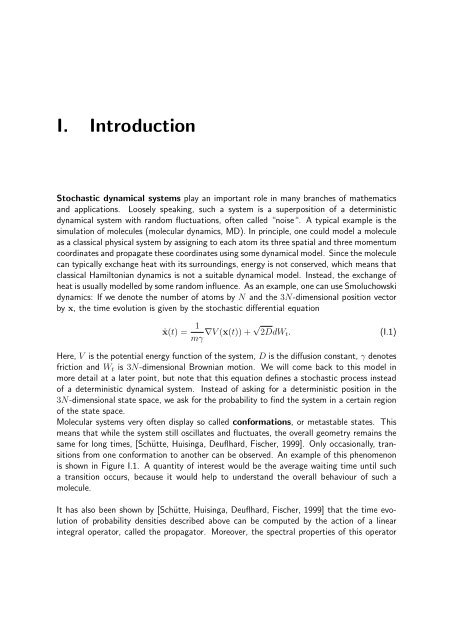Variational Principles in Conformation Dynamics - FU Berlin, FB MI
Variational Principles in Conformation Dynamics - FU Berlin, FB MI
Variational Principles in Conformation Dynamics - FU Berlin, FB MI
- No tags were found...
You also want an ePaper? Increase the reach of your titles
YUMPU automatically turns print PDFs into web optimized ePapers that Google loves.
I. IntroductionStochastic dynamical systems play an important role <strong>in</strong> many branches of mathematicsand applications. Loosely speak<strong>in</strong>g, such a system is a superposition of a determ<strong>in</strong>isticdynamical system with random fluctuations, often called “noise“. A typical example is thesimulation of molecules (molecular dynamics, MD). In pr<strong>in</strong>ciple, one could model a moleculeas a classical physical system by assign<strong>in</strong>g to each atom its three spatial and three momentumcoord<strong>in</strong>ates and propagate these coord<strong>in</strong>ates us<strong>in</strong>g some dynamical model. S<strong>in</strong>ce the moleculecan typically exchange heat with its surround<strong>in</strong>gs, energy is not conserved, which means thatclassical Hamiltonian dynamics is not a suitable dynamical model. Instead, the exchange ofheat is usually modelled by some random <strong>in</strong>fluence. As an example, one can use Smoluchowskidynamics: If we denote the number of atoms by N and the 3N-dimensional position vectorby x, thetimeevolutionisgivenbythestochasticdifferentialequationẋ(t) = 1mγ ∇V (x(t)) + √ 2DdW t .(I.1)Here, V is the potential energy function of the system, D is the diffusion constant, γ denotesfriction and W t is 3N-dimensional Brownian motion. We will come back to this model <strong>in</strong>more detail at a later po<strong>in</strong>t, but note that this equation def<strong>in</strong>es a stochastic process <strong>in</strong>steadof a determ<strong>in</strong>istic dynamical system. Instead of ask<strong>in</strong>g for a determ<strong>in</strong>istic position <strong>in</strong> the3N-dimensional state space, we ask for the probability to f<strong>in</strong>d the system <strong>in</strong> a certa<strong>in</strong> regionof the state space.Molecular systems very often display so called conformations, ormetastablestates. Thismeans that while the system still oscillates and fluctuates, the overall geometry rema<strong>in</strong>s thesame for long times, [Schütte, Huis<strong>in</strong>ga, Deuflhard, Fischer, 1999]. Only occasionally, transitionsfrom one conformation to another can be observed. An example of this phenomenonis shown <strong>in</strong> Figure I.1. A quantity of <strong>in</strong>terest would be the average wait<strong>in</strong>g time until suchatransitionoccurs,becauseitwouldhelptounderstandtheoverallbehaviourofsuchamolecule.It has also been shown by [Schütte, Huis<strong>in</strong>ga, Deuflhard, Fischer, 1999] thatthetimeevolutionof probability densities described above can be computed by the action of a l<strong>in</strong>ear<strong>in</strong>tegral operator, called the propagator. Moreover, the spectral properties of this operator









